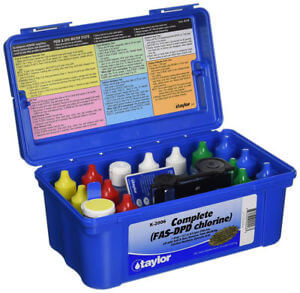Borate Plaster Pool Startup
with Chemical Addition Worksheet
On Pool Filling Day, test and record the incoming or source water for:
You will need a good test kit, not test strips.
Do not assume that you know what these water conditions are in the local water. Many water treatment plants are using different water treatment techniques and additives to deal with aging pipes and drought conditions. Many are using more recycled water. They change treatments often. Even from one day to the next can be different.
If possible, use an approved municipal drinking water source. Well water, surface, lake or river water should be avoided due to unknown contaminants, metals and minerals. Water can be trucked in.
If source water has iron or copper that total more than 0.4 ppm, consider using a pre-filter that removes metals in incoming water and using a sequestering agent or stain preventer as the pool is filling.
Chemicals Needed
- Sequestering agent – metal remover, chelator or stain preventer – could also use a pre-filter
- Calcium chloride – hardness increaser
- Boric acid – pH buffer, algae preventer
- Muriatic Acid – pH and alkalinity decreaser
- Sodium bicarbonate – total alkalinity increaser and pH buffer
- CYA (cyanuric acid) – chlorine UV protector and a pH buffer
- Liquid chlorine or bleach
Please read the disclaimer at the end of this document
Pool Filling Day Information – Getting Ready
If you are going to use a water pre-filter for sediment or metals, attach it before beginning.
Before beginning filling, attach or tie a rag, towel, T-Shirt or other material over the end of the hose. This will prevent the metal or hard plastic hose end from scratching the new plaster. This will also prevent the hose from whipping around. Make sure that the hose reaches the pool bottom at the deepest part of the pool. Do not use a hose that only reaches the shallow end of the pool because streaking may occur. The hose should enter the pool from the location that is shortest to the deepest part of the pool. This prevents the hose from laying on the plaster.
To get an idea of how long it will take to fill the whole pool, try filling a 5-gallon bucket from the hose and count the time or seconds it takes to fill it. If it takes 30 seconds, then your pool will fill at the rate of 600 gallons per hour (5 gals × (60 secs/min ÷ 30 secs) × (60 min/hr) = 600 gals/hr or about 25 hours to fill 15,000 gallons. (15,000 ÷ 600 = 25)
Do not turn off the water at any time until the pool has filled completely. The proper fill level is usually in the middle of the skimmer or specified by the builder. If the water is turned off, a permanent water line will be etched into the plaster where the water stopped.
- Do not turn on the pool light until the light is covered with water.
- Do not use a vacuum head with wheels or any automatic pool cleaner for at least 3 weeks. They can leave permanent marks in the plaster.
- Do not add salt or turn on Saltwater Chlorine Generator (SWG) for 28 days.
- Make sure that the filtration system and pump are operational. Check for proper amount or level of sand, and make sure filter cartridges are in place. For DE filters, add DE once pool is filled and pump is running.
- No people or pets should enter the water until the startup procedures are completed and the water is balanced. This may be Day 3 or 4.
- The proper fill level is the middle of the skimmer opening or specified water level.
Once the pool is filled, prime the pump. This is accomplished by removing the pump strainer pot lid, filling the pump strainer pot with water, securing the lid and turning on the pump. To help prime the pump, place a hose down the skimmer line and turn on the water. Now is a good time to check the pressure gauge and record the clean filter pressure PSI (pounds per square inch) or mark it on the pressure gauge. The pump and filtration system should be run continuously for the first 72 hours.
After the pool is filled, test the water again to verify that the pH, total alkalinity, calcium hardness and TDS are the same as the source water test made earlier. Record the results.
Brushing the pool surface twice a day is necessary









Leave a Reply
Your email is safe with us.
You must be logged in to post a comment.